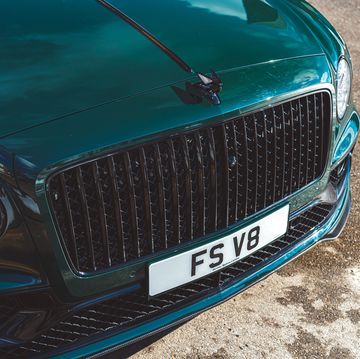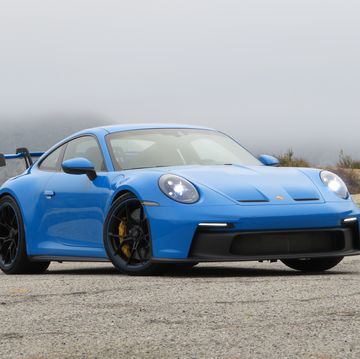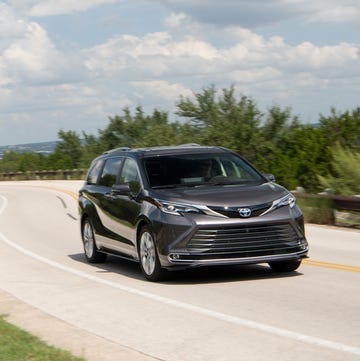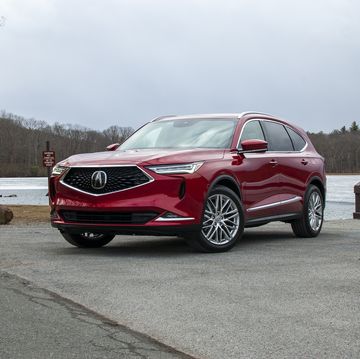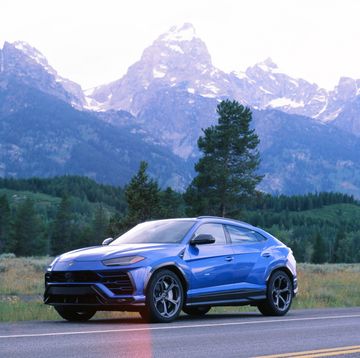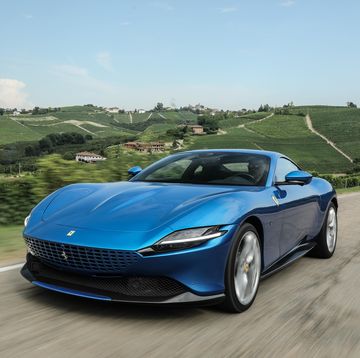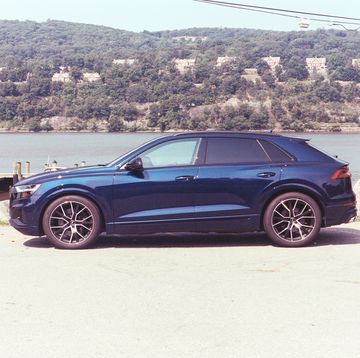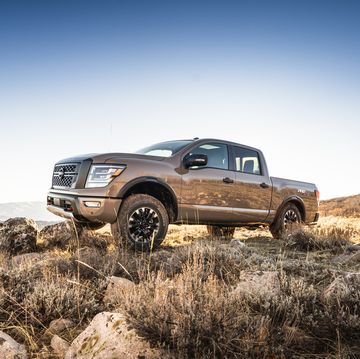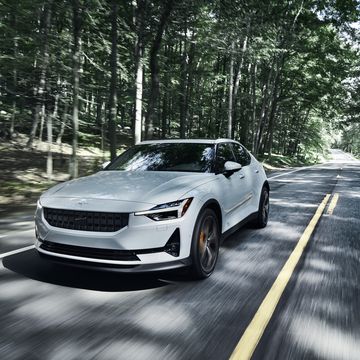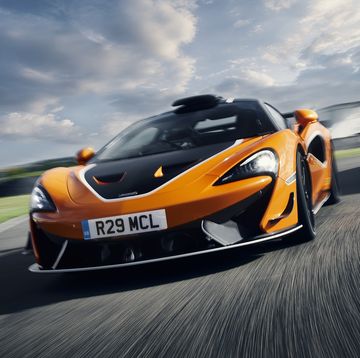The following article comes word-for-word from the August 1987 issue of Road & Track.
When the red 4-door pulled out to pass his slow-moving tractor-trailer rig, the trucker shook his head. There was no way a sedan, even a Mercedes-Benz 300E, could get out, around and back into its the proper lane in that little space this short stretch of straight highway provided. Shoot, he'd probably have to get on the binders and let that lunatic tuck in ahead of his big rig. Imagine the truck driver's surprise when the Merc blasted by, then almost as quickly slotted itself into the queue as if it had been there all along. Sedans aren't supposed to be able to do that. Sports and muscle cars, maybe. But family 4-doors, even Mercedes? Never. Alas, what the fellow didn't know was that this was no ordinary Benz but an AMG Hammer, the family sedan that doesn't just think it's an exotic; it runs like one. Zero to 60 in 5.3 seconds, top speed 180-plus mph, just like the Ferrari GTO or Testarossa without any sacrifice in comfort, room, or quietness.
Obviously, the Hammer is not exactly your mass-produced Merc. It's a selectively equipped 300E impeccably turned out by AMG, the German tuning firm specializing in those other stars from Stuttgart. For those of you who don't know, AMG is to Mercedes what Alpina is to BMW, Ruf to Porsche, Treser to Audi. The firm was founded in 1967 by Hans-Werner Aufrecht and Erhard Melcher, two former Daimler-Benz engineers, and its name comes from the initials of their last names and of Grossaspach, Aufrecht's birthplace. AMG supplies a full line of show-and-go components to followers of the 3-pointed star who seek to enhance the appearance, handling, and performance of their Mercs. It also sells complete cars, including an extensively modified 300E known as the Hammer, its most outrageous model.
At first glance it's tempting to dismiss this sedan as nothing more than a Mercedes-Benz W124 with café racer bodywork. That's understandable. Every fly-by-night automotive- fiberglass shop is into aero, and the Hammer's swoopy front and rear spoilers, side skirts, and fender flares are out of the same mold, or so it would seem. However, AMG assures us that its aero aids have been wind-tunnel tested and give the Hammer its remarkably low .25 Cx (says AMG) that enables the 4-door to slip through the air like a phantom, to achieve top speeds normally associated with the world's fastest exotic cars.
You say those highly polished flat spoke wheels look a bit garish? Maybe so. But these 8-in. wide, 17-in. tall alloys are a perfect fit for those 215/45VR-17 front and 235/45VR-17 rear Pirelli P700 tires that give the Hammer lateral acceleration equal to the stickier sports cars and (when combined with stiffer springs, re-valved shocks and stiffer anti-roll bars) endow it with handling comparable to that of the best GTs.
Of course, all of this is just frosting on the cake because what makes the Hammer unique is AMG's mind-bending V8 that churns out an impressive 365 bhp even after it's been sanitized to meet U.S. emissions standards. Designed by Melcher (no longer part of AMG but under contract to the firm), the KE-Jetronic-equipped power plant is based on a 5.6-liter Mercedes aluminum V8 that's been bored out to 6.0 liters, fitted with special 9.8:1 pistons and topped off by Melcher's 4-valve, double overhead-cam cylinder heads. Such a pretty sight. Also, a pretty hefty package, especially when shoehorned into the W124 engine compartment where M-B's longer but skinnier sohc 3.0-liter, 177-bhp six usually reposes. Not only is the V8 fatter than the inline-6, but also it's about 100 lb heavier. Normally, this would upset weight distribution a tad. But with the installation of a stronger rear subframe and heftier W126 components, springs, suspension bits, disc brakes, transmission, driveshaft, and rear differential, that extra 800 lb (for the total package) is spread more equitably throughout the chassis, so that the car's balance is better than the stock 300E's. If that's not enough, the battery has been moved to the trunk in a further attempt to restore front-to-rear balance. One more thing: The metal spoiler that's an integral part of the rear deck lid adds a few extra pounds to the back end.
Inside, the AMG influence is minimal. But it includes a custom steering wheel, wooden shift knob, wooden dash and door panel trim, deep-pile floor mats emblazoned with the AMG logo and (best of all) a gorgeous AMG speedometer that reads up to 190 mph. Gilding the automotive lily? Not in the Hammer. Granted, you may never see the speedo's needle reach 5 o'clock. But with 360 or so ponies on tap, you'll find yourself whistling up to 2 or 3 o'clock without even trying . . . as we discovered after spending several exciting days dashing about Southern California in our bright red test car. It was provided for us by Andy Cohen, owner of Beverly Hills Motoring Accessories,, AMG's West Coast distributor. (200 S. Robertson Blvd, Beverly Hills, Calif. 90211; 213-657-4800). In addition to being the only Hammer in America, our car had the distinction of being the first to be built in the U.S. Although the engine and components came from Germany, the conversion (of an American-spec 300E) took place at AMG of North America (233 W. Ogden Ave, Westmont, Ill. 60559; 312 971-2002).
The big V8 fires up easily and shakes the ground as it goes. Dual 928 S 4 catalytic converters emit a melodious burble when the engine is loafing. Put it to work and the exhaust note becomes a roar as the revs climb to the 4-cam's 6000-rpm redline. Although AMG has built about 170 dohc V8s, this is one of the few 6.0-liter power plants in existence. The added displacement provides an increase in torque while four valves per cylinder allow the engine to breathe more freely–and to rev. Working the shifter of the Hammer's 4-speed W126 automatic deftly through the gears is fun, but not really necessary. With 400 lb-ft of torque, almost any gear is a good one, especially if you leave the selector in Drive and let D-B's minions (or is it, pinions? ) do the work. That's the lesson we learned after running the Hammer at the drag strip. We tried low-gear starts, moving the stick to the side of the Lo gate to engage D1, but found that wheelspin was excessive and that we couldn't shift fast enough to avoid overrevving the engine and causing the governor to kick in. We tried starts in D2 and still got a lot of wheelspin but not the stumble caused by overrevving. Finally, we simply left the lever in Drive and found that, all things being equal, the Hammer still managed some mind-boggling-tire smoking elapsed times–5.3 sec from 0 to 60, 13.5 sec to the quarter mile. Oh, we did find a way to avoid wheelspin in the Hammer; racing slicks. By locking up the brakes and spinning the rear wheels in a puddle of water to get 'em good and hot, we got the Hammer to "hook up" and shaved about .5 sec off our best 0 to 60 and quarter-mile elapsed times.
Okay, so the Hammer's a rocket. But how does it handle? Lateral acceleration is reasonably good, the torque of the big V8 enables you to squirt from turn to turn in a flash, and ABS allows you to late-brake deep into every corner at speeds most enthusiast drivers are accustomed to, let's say, 7/10ths. But at 9/10ths or 10/10ths, the AMG gets a bit nervous because there's more engine than chassis. Power is a 2-way street: Applying it gently but progressively in a corner can cause the car to understeer, probably because the rear wheels, assisted by the limited- slip, are getting a better bite than the front wheels; on the other hand, applying it suddenly and excessively in a turn can break loose the rear wheels and induce oversteer. Of course, most muscle cars do this, and we love them for it. So we should love the Hammer right? Yes. And we do, in that context. But the Hammer is no Camaro or Mustang, and considering the company this car is expected to keep, handling could be better or at least more manageable.
So who needs handling when all most people want to do is whistle along at, how fast was that again, 180 mph? Yes, that's the top speed all right. Actually, it's a bit more. Or so say the folks at AMG who clocked a European 5.6-liter Hammer at 303 km/h (187 mph) on the Autobahn. We never had the chance to probe the car's upper limits although we did spend a lot of time at 130 mph where our red sedan proved to be rock steady and impressively quiet–save for the rumble of that magnificent AMG 32-valver.
You'll probably never see another one like it because more than likely you'll never see a Hammer. Unless you buy one of your own. Turnkey ready, a Hammer costs $161,422, but if you already own a 300E and want to have it converted into a Hammer, deduct $39,000 from that figure. That leaves only $122,422, which breaks down like this: Mercedes-Benz 5.6-liter engine with KE-Jetronic, $17,000; modification to 6.0-liter dohc, $39,950; Hammer conversion package (heavy-duty rear subframe, W126 rear differential with Gleason-Torsen limited- slip), $33,302; AMG suspension kit, $1495; AMG wheels with Pirelli P700 tires, $5050; AMG aero body kit, $4125; installation and painting of body and parts, $3500; labor, $18,000.
At full pop or at the discount price, you're buying exclusivity. There are only 13 Hammers in the world, including this car, the only one of its kind in America. But more than exclusivity, you're buying the fastest Mercedes in the world, an automobile with the body of a 4-door sedan and the soul (and performance) of an exotic.



